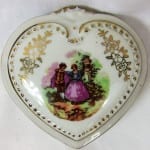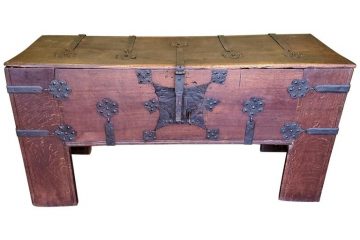Exceptional 19C French Empire Style Buffet/Vitrine by AME Fournier
PRESENTING an OUTSTANDING, IMPORTANT and UNIQUE 19C French Empire Style Buffet/Vitrine by AME Fournier.
Pieces by A.M.E. Fournier are EXTREMELY RARE and next to impossible to find, so to have discovered this piece is FANTASTIC.
Best known for his rope twist chairs/stools and upholstery, ‘Fournier’ furniture pieces are considered amongst some of the VERY BEST late 19th Century French pieces you can find, if you are lucky enough to find one!
The QUALITY of this piece throughout is SIMPLY STUNNING!
It consists of 3 pieces/sections: –
(1) The top section consisting of 2 vitrines/display cabinets on both ends, each with glass fronts and sides for viewing and 2 glass shelves inside. The rear panel in each, is a mirror. The section curves beautifully to a central mirrored section consisting of 9 mirrored panels with 4 ormolu rosettes separating the mirrors. All richly embellished with the finest quality ormolu mounts, with exceptional detail to each. The 2 side vitrines, also have Romanesque side pillars of columns to the front. The entire top section is made of the most GORGEOUS burl walnut with satinwood stringing as an inlay.
(2) The top section then rests on a GORGEOUS Siense Marble counter with beveled edges. Thick slab and very heavy!
(3) The base section or Credenza Section, has 2 side drawers to the top on either side (under the marble) and a large drawer in the middle. It has 4 doors to the base. Again, it is made of the most stunning burl walnut and richly embellished with the finest quality ormolu mounts with exceptional detail to each. The drawers have ormolu Bacchus heads and florettes. The doors open to reveal wooden shelving. The piece sits on 8 Ormolu and acanthus mounted legs.
THIS IS AN EXCEPTIONALLY IMPORTANT PIECE OF FRENCH FURNITURE, BY THE EXTREMELY RARE MAKER, FOURNIER OF PARIS, AND THE ORMOLU MOUNTS ARE AMONGST THE BEST QUALITY & DETAIL, WE HAVE EVER SEEN ON A FRENCH PIECE!
Marked “Fournier” on the door escutcheons/lock plates with serial number ‘8613’.
| A.M.E Fournier: A.M.E Fournier was established by 1850 at 109 boulevard Beaumarchais, and later at boulevard des Capucines. As well as exceptional case furniture, Fournier was famed for his upholstered work, exhibiting at many of the great exhibitions of the period, including the Exposition Universelle of 1867. His most famous creation was a wonderfully naturalistic giltwood rope twist stool, which was as highly sought after in his own period as it is today. The Empire Style: In 1804 Napoléon I, crowned himself Emperor of France, ending years of political instability and signalling the dawning of the Empire period. During this time, the economy was booming and a new aristocracy was forming, with Napoléon’s court as its cornerstone. The period was to see the revival of classical ideas and influences, primarily in the decorative arts. Napoléon’s court was quick to adopt the classical designs discovered in the archaeological excavations of Pompeii and Herculaneum, together with exotic hieroglyphic motifs from the Egyptian campaigns. Revolutionary conquests were echoed in the use of antique forms in architecture and the decorative arts, proclaiming ‘fame’ and ‘victory’. The use of these ancient designs and motifs celebrated France as the heir to these great civilisations imbuing it with the grandeur of Greece, the glory of Rome and the magnificence of the Pharaohs. Typical Empire motifs included the acanthus leaf, anthemion (stylised honeysuckle), animal-paw feet, cornucopia, classical figures, dolphin, eagle, lyre and rosette. For ornamentation, gilt-bronze was a prerequisite. The most influential architects of the Empire style were Charles Percier (1764-1838) and Pierre-François-Léonard Fontaine (1762-1853). Official architects to Napoléon, their main responsibility was the renovation of the various royal residences, including Malmaison. Their ‘Recueil des décorations intérieures’ (1812) became the essential handbook of the Empire style. After the fall of Napoléon the Empire style continued to be in favor for many decades, with only minor adaptations. The second half of the nineteenth century was to see a revival of the style, and the popularity of its strong but simple lines continues to the present day. Book References Ledoux – Lebard, Denise. Les Ébénistes du XIXe siècle, Les Editions de L’Amateur, (Paris), 1984; p. 209. |
Fournier A.M.E. upholsterer, established in Paris, 109 Boulevard Beaumarchais in 1850, then 12 Boulevard des Capucines in 1867. He presented at the Universal Exhibition of paris in 1867 a tapestry, furniture of living room and bedroom.
National Museum of the Château de Compiègne : “Pouf à cordes”, n ° 88 of the guide of the Museum of Compiègne, by M.Terrier . A pouf à cordes by Fournier is in the château de Compiègne and is illustrated in H. Hayward, World Furniture, London, 1965, p. 241, pl. 928, and in J.-M. Moulin, ‘The furnishing of the Palace of Compiègne during the Second Empire’, The Connoisseur, December 1978, p. 253. A giltwood stool of the same design was sold by the Earl of Rosebery from the collection of Baron Mayer Amschel de Rothschild, Mentmore, Sotheby’s House sale, 18 May 1977, lot 10.
Link: https://www.metmuseum.org/art/collection/search/207512


Exceptional 19C French Empire Style Buffet/Vitrine by AME Fournier
Provenance: From a Private Louisiana Collection.
Condition: Very good original condition. The marble counter has a couple of chips on the edges and a repaired crack in the center, but not very noticeable. One very minor repair to the side base (a filled crack no more than 2 inches long) and does not in any way detract from the piece. Has been wired for illumination in both vitrines, but non-intrusive wiring. No keys.
Dimensions: 86 inches Tall, 84 inches Wide and 24 inches Deep.
PRICE: $126,000 – SALE PRICE NOW: $76,000
































































